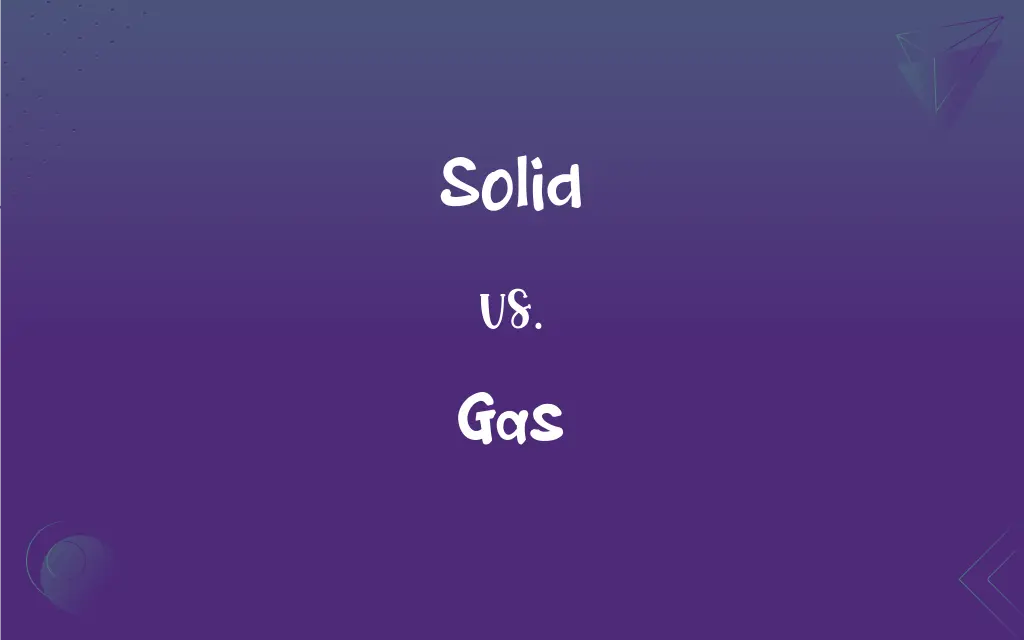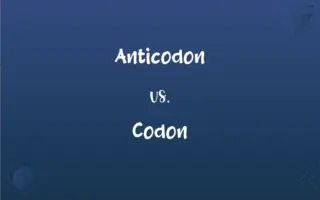Solid vs. Gas: What's the Difference?
Edited by Aimie Carlson || By Harlon Moss || Updated on October 26, 2023
Solids have fixed shape and volume; gases have no fixed shape or volume and expand to fill their container.

Key Differences
The primary distinction between solids and gases lies in the arrangement and movement of their constituent particles. In a solid, atoms or molecules are tightly packed in a fixed and orderly arrangement, allowing solids to maintain a definite shape and volume. Conversely, in gases, the particles are far apart and move freely, resulting in no fixed shape and the ability to expand indefinitely to fill any container. This fundamental difference in particle arrangement and movement underpins the contrasting properties of solids and gases.
When considering the response to temperature changes, both solids and gases exhibit distinct behaviors. In solids, the closely packed particles vibrate around fixed positions, and when heated, the vibration increases but the solid largely retains its shape. In gases, the particles move rapidly and are already far apart; heating a gas increases the speed of the particles, leading to expansion and a decrease in density. This contrast in thermal responses highlights the unique characteristics of solids and gases.
Compressibility is another aspect where solids and gases differ markedly. Solids are generally incompressible due to the tight packing of their particles, meaning applying pressure does not significantly decrease their volume. Gases, however, are highly compressible because of the large spaces between particles; applying pressure can significantly reduce their volume. This difference in compressibility is a key factor in numerous practical applications, ranging from hydraulic systems utilizing the incompressibility of solids to the storage of gases under high pressure.
Diffusion rates are drastically different between solids and gases, due to the nature of their constituent particles. In solids, the particles are fixed in place, leading to extremely slow diffusion rates as atoms or molecules can only move by vibrating or through defects in the solid structure. In gases, the particles move rapidly and freely, resulting in much higher diffusion rates. This is why a gas can quickly spread throughout a room, while diffusion in solids is a much slower process.
The strength of intermolecular forces in solids and gases also greatly differs. In solids, the intermolecular forces are strong, holding particles tightly together and giving solids their rigid structure. In gases, these forces are negligible due to the large distances between particles, allowing gases to flow and take the shape of their container. This fundamental difference in intermolecular forces is a cornerstone in understanding the distinct physical states of solids and gases.
ADVERTISEMENT
Comparison Chart
Type
Pasta made from semolina
Seed, often used like a grain
Origin
North African
South American
Cooking Method
Steamed
Cooked in water like rice
Nutritional Profile
Lower in protein, vitamins
Complete protein, rich in nutrients
Culinary Uses
Salads, stews, side dishes
Salads, soups, side dishes, baking
ADVERTISEMENT
Solid and Gas Definitions
Solid
Pasta from semolina flour.
She made a delicious vegetable stew with couscous.
Gas
South American origin.
Quinoa has been a staple in Andean cuisine for centuries.
Solid
Tiny granules of durum wheat.
He sprinkled some herbs over the steamed couscous.
Gas
Gluten-free ancient seed.
Quinoa is a great choice for gluten-free diets.
Solid
Quick-cooking and versatile.
For a quick meal, she opted for couscous salad.
Gas
Complete protein source.
Vegans often use quinoa as a protein source.
Solid
Often steamed and fluffed.
The couscous was perfectly fluffy and light.
Gas
Versatile in cooking.
He added quinoa to his morning smoothie bowl.
Solid
North African staple food.
Couscous is a must in traditional Moroccan dishes.
Gas
Nutrient-rich pseudo-grain.
She substituted rice with quinoa for extra protein.
Solid
Of definite shape and volume; not liquid or gaseous
It was so cold the water in the bucket became solid.
Gas
The state of matter distinguished from the solid and liquid states by relatively low density and viscosity, relatively great expansion and contraction with changes in pressure and temperature, the ability to diffuse readily, and the spontaneous tendency to become distributed uniformly throughout any container.
FAQs
Is quinoa good for weight loss?
Quinoa can be part of a healthy diet for weight loss due to its high protein and fiber content.
What is couscous made from?
Couscous is made from semolina wheat.
Can couscous be eaten cold?
Yes, couscous can be served cold in salads.
How do you cook quinoa?
Quinoa is cooked by boiling in water, similar to rice.
Is couscous gluten-free?
No, couscous is not gluten-free as it's made from wheat.
Is quinoa keto-friendly?
Quinoa is higher in carbs and may not be suitable for a strict keto diet.
Is couscous good for diabetics?
Couscous is high in carbohydrates and should be consumed in moderation by diabetics.
What are the health benefits of quinoa?
Quinoa is high in protein, fiber, vitamins, and minerals.
What does quinoa taste like?
Quinoa has a nutty, earthy flavor.
Is quinoa a grain?
Quinoa is a seed, but often used like a grain.
Can quinoa be eaten raw?
Quinoa should be cooked as raw quinoa can be hard to digest.
How long does cooked quinoa last?
Cooked quinoa can last in the fridge for 3-5 days.
Does couscous have any health benefits?
Couscous provides carbohydrates and is low in fat.
Can quinoa be used in baking?
Yes, quinoa can be used in baking, such as in bread or muffins.
Is couscous easy to digest?
Couscous is generally easy to digest.
What are the different types of quinoa?
There are several types, including white, red, and black quinoa.
Can couscous be reheated?
Yes, couscous can be reheated.
Does couscous contain protein?
Couscous contains some protein, but it's not a complete protein source.
What is the origin of couscous?
Couscous originates from North Africa.
What dishes use couscous?
Couscous is used in salads, stews, and as a side dish.
About Author
Written by
Harlon MossHarlon is a seasoned quality moderator and accomplished content writer for Difference Wiki. An alumnus of the prestigious University of California, he earned his degree in Computer Science. Leveraging his academic background, Harlon brings a meticulous and informed perspective to his work, ensuring content accuracy and excellence.
Edited by
Aimie CarlsonAimie Carlson, holding a master's degree in English literature, is a fervent English language enthusiast. She lends her writing talents to Difference Wiki, a prominent website that specializes in comparisons, offering readers insightful analyses that both captivate and inform.































































